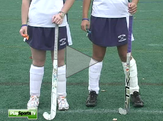10 Essential Field Hockey Rules

Coaching field hockey rules is as important as teaching skills.
Coach your youngsters with a solid base of rules
By Craig Haley
PSTV Managing Editor
Young field hockey players will come to learn there are many stoppages during a game. It's as important for a coach to teach field hockey rules as skills.
As players learn the rules, they will understand the positions and fundamentals better. To get your youngsters started, coach these 10 important field hockey rules:
Holding the stick. Perhaps the most well-known field hockey rule, players can only play the ball with the flat side of their stick and not the back of their stick. Also, players are not allowed to hold the stick up in dangerous fashion.
Center pass. Play is started in each half and after each goal with a center pass at the middle of the field. The center pass can be played in any direction and players can move upon the umpire's whistle, even before a player strikes the ball.
Playing the ball. A field player is not allowed to intentionally stop, kick, propel, pick up, throw or carry the ball with any part of her body.
Free hit. A free hit is awarded when a rules violation is committed outside the scoring circles. The free hit restarts play.
Out of bounds. When the ball goes over the sideline, play restarts with a free hit at the spot where the ball crossed out of bounds.
Dangerous play. The field hockey ball must be played safely, especially when it is lifted in the air. A ball is considered dangerous when it causes legitimate evasive action for other players.
Play on. Play continues when the ball strikes an umpire or loose object on the field (which sometimes happen on a grass field).
Penalty corner. There are plenty of penalty corners during a field hockey game. One is awarded for various reasons: an offense by a defender in the circle; an intentional offense by a defender outside the circle but within the 23-meter defensive area; when a defender other than the goalkeeper intentionally plays the ball over the back line; or when the ball becomes lodged in a defensive player’s clothing or equipment while inside their defensive area. These penalty, or short, corners begin with five defenders (including the goalie) positioned behind the back line and at least five meters from the “insert” position of the ball. All other players in the defending team must be beyond the center line that is not in their “own” half of the field until the ball is in play. Attacking players begin the play standing outside the scoring circle, except for one attacker who starts the corner by playing the ball from a mark 10 meters on one side of the goal. This player who puts the ball into play will push or hit the ball to the other attackers outside the circle.
Penalty stroke. On a penalty stroke, all players must be outside the 23-meter defensive circle except for the player taking the shot (which is 6.4 meters away from the goal) and the field hockey goalie, who must stand on her goal line until the stroke is taken.
Goalie stops. Within her team’s goalie circle, a field hockey goalie can use any part of her body or protective gear to stop the ball. When outside the circle, the goalie can only play the ball with her stick.




